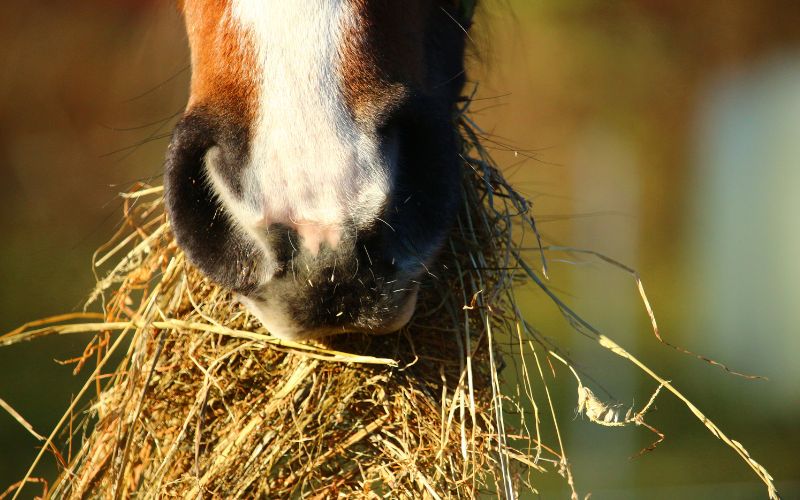
Forage based diets for horses are becoming more common as owners discover the benefits of feeding less grain and other processed feeds. Have you heard “forage-based diet” as a buzzword online or at your barn and wondered if it’s an option for your horse? Let’s cover how a forage based diet is different, the perks for your horse, and how to transition your horse onto this healthful feeding strategy.
What is a forage-based diet for horses?
A forage-based diet for horses is a feeding strategy where grass-based products make up most or all of your horse’s calories. This might include pasture, hay, or cubed/pelleted hay. In contrast, little or no formulated “horse feed” grain products are fed. Sounds simple, right?
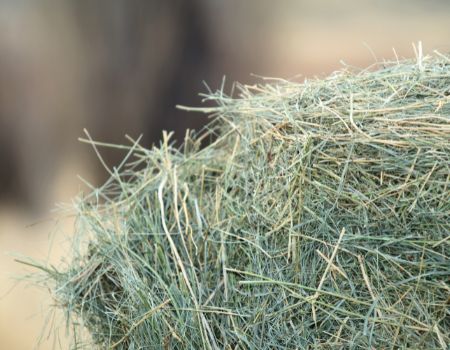
A forage-based diet is simple. It does take a little time and research to decide on the right type and amount of forage, and to pick the best supplement options for minerals and other needs. But once you begin feeding a forage based diet to your horse, it’s not more work than how you’ve been feeding.
In fact, forage-based diets can often reduce the amount of time you spend making and mixing “meals” for your horse.
Forage-Based vs Modern Horse Diets
A forage based diet for horses means that forage is the main calorie source, instead of grain. So what’s forage?
Horses are grazing animals. Equines are adapted to meet their nutrient needs by eating lots and lots of high-fiber, low calorie grass. That’s “forage.”
But many horses today, especially working athletes and hard keepers, eat a lot less forage than nature intended.
A huge proportion of many horses’ daily energy now comes from grains or processed feeds. In a “modern” diet, a horse is often given a flake or two of hay per day. They might be turned out onto grass for part of the day. But in addition, most horses also receive daily meals of grain-based “equine feeds” or unprocessed grains such as oats.
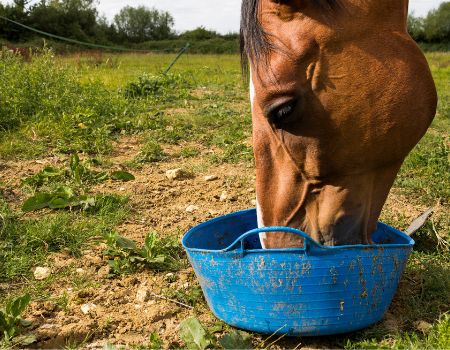
Processed feeds are an easy way to get a lot of calories and energy into a horse in a single meal. A forage based diet for horses is based on the idea that these heavily marketed feeds aren’t the only diet options out there – and might not be the best choice for many horses.
Easy keepers are best known for doing well on a diet with less grain and processed feed, but they aren’t the only ones that can benefit. For many horses, more forage and less grain can be better for physical and mental health.
What does a forage-based diet look like?
A forage based diet for horses is probably similar to what you’re feeding now, with a few major changes.
It begins with a lot of forage in the form of pasture or hay. On this diet, your horse will have access to forage at almost all times just like nature intended. You’ll keep them at a healthy weight by either slowing down their rate of eating, or adding forage-based calories as needed.
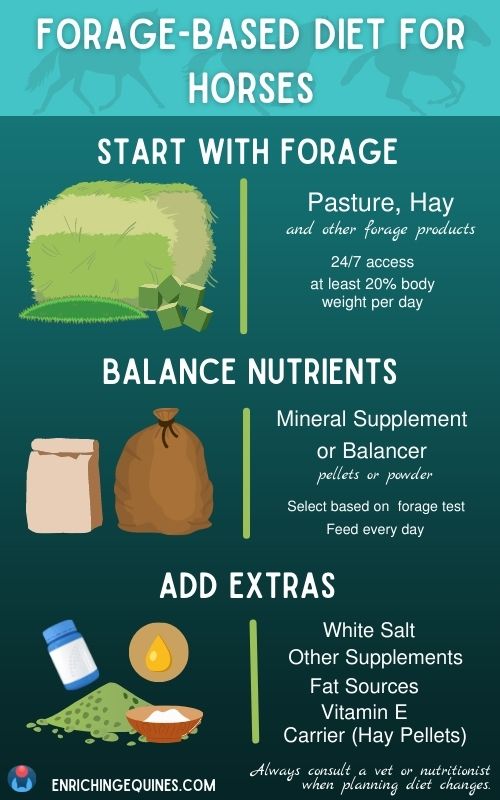
To balance the the nutrition in your hay and pasture, a forage based diet should also include a mineral supplement or “forage balancer.”
These products are available as pellets or powder depending on the brand. They’re often formulated for specific regions. Unlike complete equine feeds, mineral balancers are intended to be fed in very small amounts per day.
You’ll feed your mineral supplement in a small meal that also delivers any extras your horse needs, like joint supplements, salt, or fats. If your horse needs extra calories, extra forage-based products like beet pulp or alfalfa cubes might also be included.
Feeding a Forage Based Diet
How do you offer a forage based diet on a daily basis?
It’s surprisingly easy. Just like your current feeding strategy, you’ll provide both forage and a prepared meal. The difference is in what goes into each.
You’ll give your horse the right amount of forage each day by turning them out on pasture or providing hay.
Many horses with access to hay all the time learn to regulate their intake and don’t overeat. For those who don’t, or to control waste, you’ll use a slow-feed hay net or other feeder. Nets are available in every size from small to round-bale.
Once or twice a day, you’ll feed the supplements that balance out your forage.
You’ll probably mix this product into a forage-based carrier your horse enjoys, like lightly soaked hay pellets.
In this small meal, add other ingredients like extra fat sources, joint products, or forage-based calorie sources.
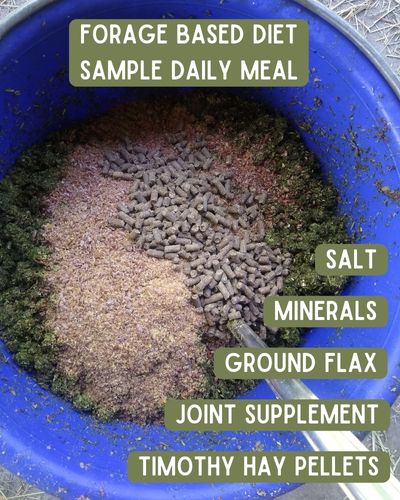
Feed in a bucket or pan just like your previous grain-based diet. But since the amount is usually much smaller, you may be able to offer your horse only one meal per day. That’s a big savings of time and effort!
Planning a Forage Based Diet
Most of the work in switching your horse to a forage-based diet happens at the beginning, when you plan out the diet.
The best way to craft a forage based diet is to send a sample of your hay or pasture for testing, and use the results to pick a supplement blend that fills in any deficiencies. Your hay will have good amounts of some minerals but be low in others. Grass varies a lot in nutrient levels, so testing is important.
You can then work with a nutritionist, or do your own research to compare mineral balancers and find one that works for you.
If you can’t test your forage, it’s possible to feed a general-purpose balancer. In this case, it’s best to choose one formulated for your region.
You’ll also need to determine how much forage your horse needs per day. If you can’t offer free choice hay, use a hay scale to weigh the hay your horse requires each day. Aim for a total forage intake of about 2 to 2.5% of their body weight. This amount of hay is often surprisingly large – that’s 20-25 pounds of hay for a 1,000lb horse – but remember, you won’t be feeding this amount plus scoops of grain or pellets each day.

When you’ve decided how much forage to offer and how to do it – such as using a hay net – review any extras your horse needs and then gradually make the switch. Change diets slowly, giving the digestive system time to adjust.
Is Forage Based Better? Why Switch?
It’s hard to make blanket statements about horse care, but a forage based diet is a healthy, appropriate option for many horses.
This is because horses’ bodies and minds are adapted for a grazing lifestyle, rather than eating heavy but intermittent meals like people. Their digestive system works best with a constant trickle of low-energy, high fiber forage. And if they’re given enough forage and have a healthy digestive system, most horses are very good at getting the energy they need from grass-based sources like pasture and hay.
Processed, bagged equine feeds are carefully formulated for different horse life stages and work needs. A lot of money goes into researching and developing these products, and many horses live and perform well on them. There are also some situations where a processed feed is the best choice.
For many owners, though, reducing the amount of grain in their horse’s diet is a priority. You may have discovered that your horse is sensitive or intolerant to some of the ingredients in bagged feed. Or you may want to stabilize a horse’s energy levels and personality by reducing sugar and starch.
And one of the best reasons to switch to a forage-based diet is that it often creates better health for your horse by encouraging them to graze. More forage can reduce the risk of ulcers and other gut problems, and also improves your horse’s mental health. It’s just plain good for horse welfare.
Can my horse eat a forage-based diet?
Yes, your horse can probably eat a forage based diet. You’ll need to do a little research and legwork to create the right diet, just like when planning a diet for a grain-fed horse.
Have a special case and aren’t sure if forage-based is right for your horse? Let’s look at a few different situations.
Forage based diets for hard keepers
If your horse seems to need pounds and pounds of feed to maintain weight, dropping most grain from their diet may seem like a terrible idea.
But many owners discover that a well crafted forage based diet improves their hard keeper’s body condition and overall appearance. Giving most of the calories in the form of hay or other grass-based options helps these horses maintain a healthy gut and make the most use of the energy they consume.
A forage based diet also helps hard keepers stay occupied with eating, as nature intended. This can reduce stress, anxiety and related health problems like ulcers. These can make it hard for horses to maintain their weight.
If your horse is a hard keeper, put careful thought into a forage based diet and be sure to speak with your veterinarian. You should also address any underlying health issues before making the switch.
Easy Keepers and Overweight Horses
Can overweight horses do well on a forage based diet?
Horses who struggle with weight control make ideal candidates for a forage based diet. Eliminating grain (and adding mineral balancing supplements instead) can help them keep their calorie intake in check.
A forage based diet prioritizes grazing or access to hay. Rich pasture or unlimited hay may not be great for these horses – but that doesn’t mean that forage-based isn’t a good switch. You’ll use slow-feeding products like hay nets with small holes to make your overweight horse’s daily hay last all day.
Horses with Metabolic Syndrome or Sugar Sensitivity
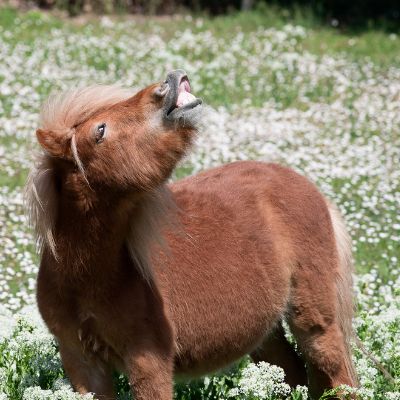
Horses with EMS (equine metabolic syndrome) or a history of laminitis may not be able to safely eat pasture grass – but that doesn’t mean that forage-based is off the table.
In fact, eliminating grain and other starchy foods is crucial for management of these horses’ insulin levels. So if your horse is recovering from laminitis or has been diagnosed with a metabolic condition, moving away from traditional feeds and focusing on forage can be a healthy, life-improving decision.
For these horses, it’s important to choose hay with appropriate levels of sugars and other carbohydrate. Supplements and sources of extra calories also need to be selected carefully.
Once their owners research a low-starch, forage based diet, many metabolic horses do very well on a more natural, low-calorie forage based diet.
Competition horses

Equine athletes can enjoy the benefits of a forage based diet too. You may worry that your horse needs grain to provide the energy needed for training or competition, but this may not be the case.
A forage based diet for an active horse needs to include enough protein for muscle growth and repair, plus energy for intense activity. But the horse may not need big meals of “performance feed” to maintain energy and weight.
In fact, moving toward more forage and less grain-based feed may maintain performance while reducing the side effects of excess carbohydrates, like hyperactivity or spookiness.
It’s also okay to add some processed feed or grain to your horse’s diet if necessary to supply energy for training or competition. Forage based doesn’t have to mean forage exclusive.
How to Switch to a Forage Based Diet
A forage-based diet may be a fantastic option for your horse. Part of the appeal of a forage based diet is that you’ll rely less on bags of processed feed with a scoop-it-and-forget-it mentality. But this means you’ll need to plan the diet carefully to make sure it meets your horse’s needs.
If you’re interested in learning more and making the switch, these pages have ample resources and support to guide you:
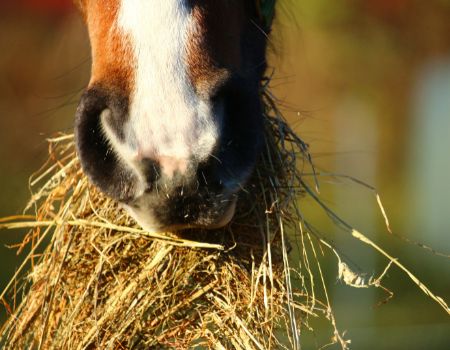
Pingback: How to Sprout Grain for your Horse [DIY Fodder] - Enriching Equines
Pingback: Hay Scales for Horses | How to Choose and Use a Scale for Your Barn - Enriching Equines